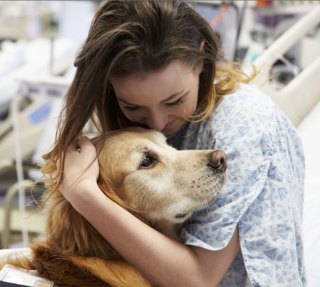Media
Media Coverage of Pet Therapy Research Often Gets It Wrong
What a study of therapy dogs on kids with cancer really found.
Posted March 4, 2019

The headline of the Augusta Chronicle proclaimed, “National Study Shows Therapy Dogs Can Aid Kids Undergoing Cancer Treatment.” The article described a new study on the impact of therapy dog visits on the well-being of children with cancer and on their parents. The study was important, and the results were interesting. But the headline was wrong. The researchers actually found that interacting with therapy dogs had no impact on anxiety or the quality of life of the kids in the study. The widespread news coverage of the study, however, nicely illustrates the problem the media has with covering research on animal-assisted therapies.
The Childhood Cancer Study
Designed and conducted by the American Humane Association, the study was an undertaking of Herculean proportions. From the initial planning stage to the publication of the final results, the study took seven years and cost about a million dollars, most of which was provided by Zoetis, the world’s large producer of veterinary pharmaceuticals. In a press release, Dr. J. Michael McFarland, the company’s Executive Director of Companion Animal Marketing, described the goals of the study, “We intentionally sought to establish a rigorous challenge and demonstrate that multi-center, prospective, placebo-controlled studies are possible in the area of animal-assisted therapy.” The president and chief executive of American Humane referred to the research as a “game changer,” and she was right. This was the most ambitious study yet of the impact of animal-assisted therapy on sick children in real-world medical settings.
The results of the research were published in the Journal of Pediatric Oncology Nursing. (You can read it here). The study had a lot going for it.
- It was a multi-site project involving five children’s cancer centers spread across the country.
- The research was a true randomized clinical trial. “RCTs” are the proverbial gold standards in medical research because participants are randomly assigned to either a treatment group that gets an intervention or a control group. Because they are true experiments, RTCs can demonstrate that interventions such as interacting with a therapy dog actually causes improvements in the health and psychological well-being of patients.
- The study included an adequately large sample: 106 children and their parents, as well as 26 teams of therapy dogs and their handlers.
- The therapy sessions were not a one-off. The children in the treatment group had four months of weekly interactions with the therapy dogs and the dogs’ handlers.
- The researchers examined how interacting with animals affected the parents and the therapy dogs as well as children with cancer. (The impact of the sessions on the dogs was published in a separate journal article. The results are described in this Psychology Today post by Stanley Coren.)
The researchers tested three hypotheses.
- Children with cancer who interact with therapy dogs would experience less stress and anxiety after four months than children in the control group.
- The children in the dog therapy group would have improved scores on quality of life measures at the end of the study compared to kids in the control group.
- The parents of children in the dog therapy group would experience less stress and anxiety over the course of the study than parents of kids in the control group.
The basic design of the clinical trial was fairly straightforward. The participants were children between the ages of 3 and 17 years old who were undergoing outpatient treatment for cancer and their parents. Sixty of the kids were assigned to the therapy dog intervention group, and 46 of them were in the no-treatment control group. On the days they were receiving chemotherapy treatments, all the children completed a childhood anxiety scale as well as scales that measured their “general quality of life” and their “cancer quality of life.” (Parents completed the scales for kids under five years old.) Every week the children’s primary caretakers completed an adult version of the anxiety scale. Once a month, the parents also completed the Pediatric Inventory for Parents, a 42 item scale that measures several dimensions of stress in parents of children suffering from serious illnesses.
The sessions for kids in the therapy dog group consisted of unstructured interactions with a dog and its handler. On average, each of the children had 10 sessions of about 20 minutes each, usually with the same dogs. Analyses of videotapes of the session revealed that the kids spent most of the time in the sessions petting and playing with their therapy dog and talking about photos of the dogs. Children in the control group received standard care in the hospital. However, they sometimes got to play with the therapy dogs in the hospital hallways. The children’s heart rates and blood pressures were taken before and after the sessions.

A Mixed Bag of Results
After a small pilot study, the full clinical trial began in 2014. Based on early results, the researchers were optimistic. However, once all the data were in, the results were, well…mixed.
Effects on Children
The researchers were surprised to find that interacting with therapy dogs did not reduce stress or anxiety in kids undergoing cancer treatments (Hypothesis 1). Nor did children in the dog group have a better quality of life at the end of the study than children in the control group (Hypothesis 2).
Interestingly, kids in the dog intervention group did show elevations in blood pressure and heart rates not found in the control group. The investigators, however, correctly argued that these differences were probably due to the fact that the kids in the dog group were more active during the sessions than the control group children.
Effects on Parents?
Now the good news. Four months of dog therapy did not have any measurable effect on children suffering from cancer. At the end of the study, however, compared with the control group, parents with kids in the dog group exhibited slightly lower levels in their emotional distress, the frequency of stressful communications, and in stressful events related to medical care.
But as the researchers wrote in the summary of their article, "However, no significant differences between groups over time on any measures were observed."
The Misleading Press Coverage Problem
Naturally, the researchers were disappointed that their study did not support the idea that interacting with therapy dogs would decrease stress and increase the quality of lives of children undergoing chemotherapy. Indeed, they wrote, “The overall lack of significantly greater improvement in children in the intervention group was unexpected…”
To the investigators' credit, however, the published journal article provided accurate descriptions of the methods and results of the study. It also included a thorough discussion of the limitations of the research and possible reasons for their negative results. And, unlike many research papers, they did not “spin” their results. This is a surprisingly common phenomenon in which authors of scientific reports purposefully omit or bury findings that do not fit their expectations (here). However, in contrast to the objective and accurate journal article, most of the press coverage of the Childhood Cancer Study was misleading in that the stories failed to even mention the most important findings – that therapy dogs did not produce any of the anticipated positive impacts on the well-being of the children undergoing treatment for leukemia.
Journalists covering science and medicine have a hard job. They are often under tight deadlines, and most of them simply do not have the time or the scientific training to wade through the jargon and statistical minutia of stacks of research papers. Further, because of the “paywalls” on most journal articles, reporters rarely have access to research reports. As a result, journalists are usually left to rely on corporate or university press releases. Often, press releases over-simplify complex patterns of results, and they accentuate positive findings and ignore negative results.
Another problem is the public’s voracious appetite for feel-good stories on the healing power of animals. I got a sense of this some years ago when I was talking to a New York literary agent about a book I wanted to write. I told the agent that, among other things, I would explain that swimming with dolphin programs have no lasting benefits for children with autism. After a long pause, she said…”Well, no one wants to read about that.
Not surprisingly, the same apparently is true of the Augusta Chronicle headline which should have been “National Study Shows Therapy Dogs Do Not Aid Kids Undergoing Cancer Treatments!"
LinkedIn Image Credit: Monkey Business Images/Shutterstock
References
McCullough, A., Ruehrdanz, A., Jenkins, M. A., Gilmer, M. J., Olson, J., Pawar, A., ... & Grossman, N. J. (2018). Measuring the effects of an animal-assisted intervention for pediatric oncology patients and their parents: A multisite randomized controlled trial. Journal of Pediatric Oncology Nursing, 35(3), 159-177.




